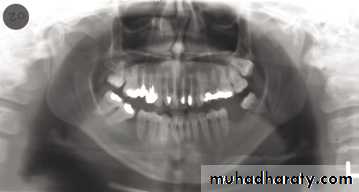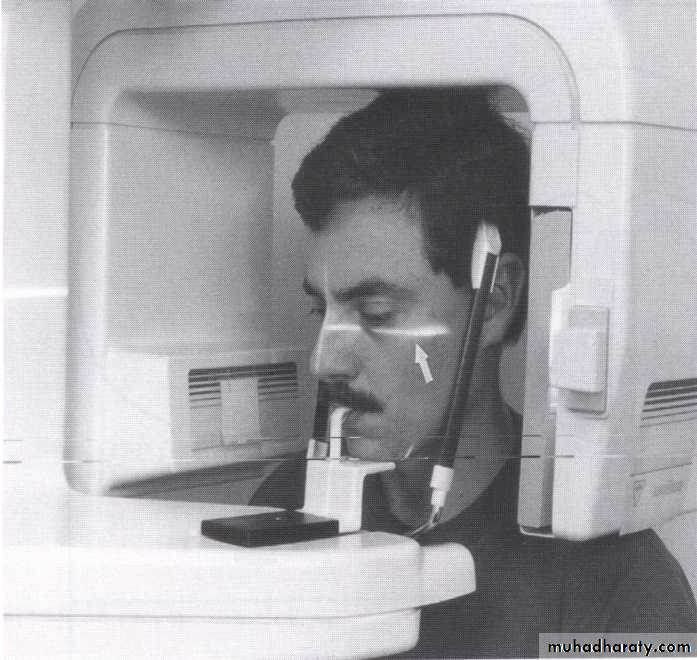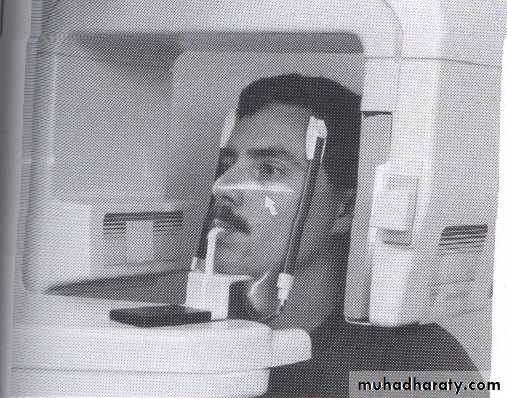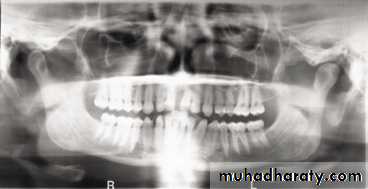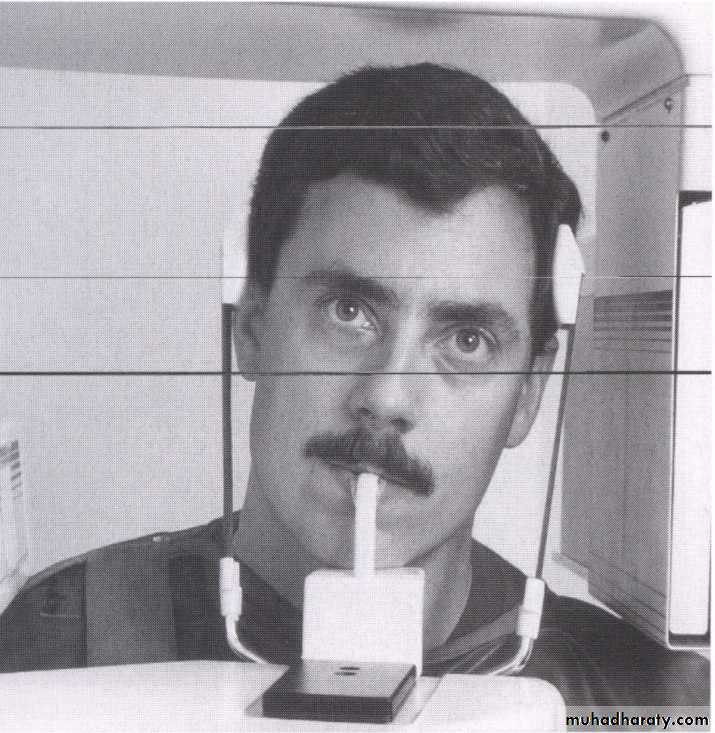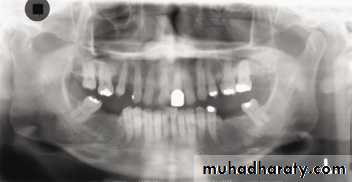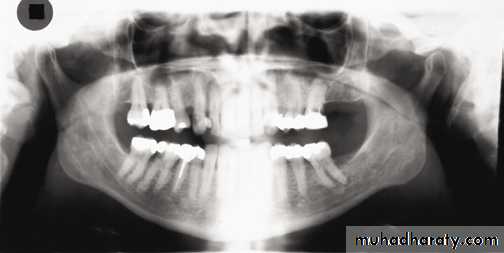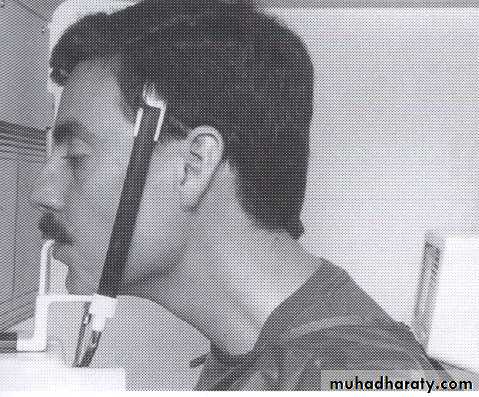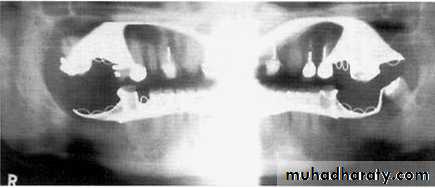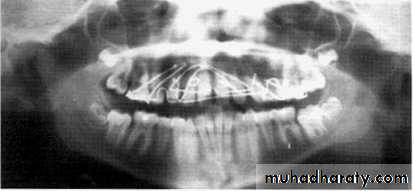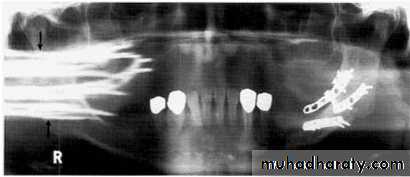Dental Panoramic Radiography
Dental panoramic radiography has become a very popular radiographic technique in dentistry because:All teeth & their supporting structures are shown in one film .
Simple technique .
The radiation dose relatively low .
1.Orthodontic assessment (presence & position of developing teeth) .
2.Lesion such as cysts ,tumors & developmental anomalies in the body & ramie of mandible to establish their size &site.3.Fractures of all parts of mandible except the anterior part .
4.Investigation of maxillary antrum , to assess the floor, posterior & anterior walls .
5.Investigation of articular surface of the head of the condyle , specially if the patient with the mouth opening limitation .
Indication
6.Assessment of any underlying disease before construction of partial & complete denture .7.Assessment of the presence & position of wisdom teeth .
8.Evaluation of vertical height of alveolar bone before inserting implant .
9.Periodontal condition ; as an overall view of the alveolar bone level but it should be supplemented by periapical radiograph .
• X-ray tube head : produce narrow fan-shape x-ray beam angled upward at 8 degree.( narrow x-ray beam emerges from the collimator minimize patient exposure to the radiation).
• A cassette & its carrier. (Rare earth screens require less x-ray exposure than calcium tungestate screen & are considered faster).
• Patient–positioning apparatus include light beam marker.
Theory of panoramic radiography
Panoramic Theory
Panoramic radiography is a modified type of tomography or image layer radiography. The patient’s dental arch must be positioned within a narrow zone of sharp focus known as the “focal trough”/imaging plane.Focal trough or Image Layer
Patient Positioning:Most panoramic machines offer positioning guides such as lights or plastic guides to position the patient along three major axes:
Anterior-posterior or canine/corner (too far forward or back).
Vertically (alartragus, Frankfort plane, or cantho-meatal lines),
Midsagittal alignment (patient twisted or rotated).
:The Basic Steps
1. Set exposure factors, if required.2. The patient should remove jewelry.
3. The patient should bite on bite rod.
4. Adjust the:
a. Chin tilt with the Frankfort light.
b. Head rotation with the mid-sagittal light.
c. Forward/backward head position with the canine light.
5. Position the side guides or head support.
6. The patient stand up straight, place the tongue on roof of the mouth, and hold still.
8. X-ray
In a good panoramic radiograph:
The mandible is “U” shaped.The condyles are positioned about equal distance from the inside edges of the image and 1⁄3 of the way down from the top edge of the image.
The occlusal plane exhibits a slight curve or “smile line,” upwards.
The roots of the maxillary and mandibular anterior teeth are readily visible with minimal distortion.
Magnification is equal on both sides of the midline.
Normal anatomy
The normal anatomical shadows can be subdivided into:True or actual image of structures in, or close to the focal trough.
Ghost images created by the tomographic movement and cast by structures on the opposite side or a long way from the focal trough. The 8° upward angulation of these ghost shadows appear at a higher level than the structures that have caused them.
Double images: structures that are scanned twice by the rotating X-ray beam.
Important hard tissue images):)True or actual images
These include:• Teeth.
• Mandible.
• Maxilla, including the floor, medial and posterior walls of the antra.
• Hard palate.
• Zygomatic arches.
• Styloid processes.
• Hyoid bone.
• Nasal septum and conchae.
• Orbital rim.
• Base of skull.
Air images
• Mouth/oral opening
• Oropharynx.
Important soft tissue images
• Ear lobes
• Nasal cartilages
• Soft palate
• Dorsum of tongue
• Lips and cheeks
• Nasolabial folds.
Ghost images
:The more important ghost shadows
• Cervical vertebrae.
• Body, angle and ramus of the contralateral side
of the mandible
• Palate.
Double images
( hyoid bone, the hard palate, epiglottis).A dental panoramic tomograph showing the main real hard tissue shadows, including the plastic head support, drawn in on one side of the radiograph, NS — nasal septum,
MIT — middle and inferior turbinates, O — orbital margin, HP — hard palate, A — floor of antrum, Z — zygomatic arch, EAM — external auditory meatus, MP — mastoid process,
SP — styloid process, H — hyoid, P — plastic head support.
A dental panoramic tomograph showing the main real soft tissue and air shadows drawn in on
one side of the radiograph, NC — nasal cartilages, EL — ear lobe, SP — soft palate,DT — dorsum of tongue, Or — oropharnyx, NF — naso-labial fold, M — mouth.
A dental panoramic tomograph showing the main anatomical ghost or artefactual shadows drawn in on one side of the radiograph, PI — palate, Md — mandible, CV — cervical vertebrae.
Errors
HintsHow to Correct
Cause
Problem
Do not confuse with fogging (film), which is an overall grayness
Increase mA or kVp or use next higher setting on machine
Too little exposure
Light, pale image with
few dark areas
Decrease machine settings
Too much exposure
Dark image with loss of details, amalgams and unex posed areas are still clear
Step 1: Setting Exposure Factors
Hints
How to CorrectCause
Problem
Watch out for necklaces
Remove prior to exposure
Ghosts of metal jewelry
White opacities on image; little
or no image is visible
Image is projected high onto
palate instead of floor of mouth
Remove prior to exposure
Tongue bar
White opacity in palate
Step 2: Have Patient Remove Jewelry, Place Lead Apron on Patient
Watch for bunching at
back of neck
Adjust and properly
place apron
Lead apron above collar line
and in X-ray beam
White opacity at bottom of
image shaped like inverted “V”
or “shark fin”
Stud earrings, real shadows (solid arrows)
with ghost shadows (open arrows).Tongue bar projected over palate
Neck collar artifact
A necklace
Step 3: Bite on Rod
Hints
How to Correct
Cause
Problem
Make sure mandibular incisors
are in groove also, and bite rod
is not being bent forward
Make sure anterior teeth are
located in grooves on rod
Patient biting too far forward
on bite rod
Anterior teeth blurry, too small
and narrow, spine visible on
sides of image
Patient too far forward; note spine superimposed over rami, blurring, and narrowing of anterior teeth
Step 3: Bite on Rod
Hints
How to Correct
Cause
Problem
If anterior teeth are missing
use edentulous guide
Make sure anterior teeth are
located in grooves on rod
Patient is biting too far back
on rod or not at all
Anterior teeth blurry and wide,
ghosting of mandible and spine,
condyles close to edge of image
Patient too far back; note ghosting of mandible and spine, condyles pushed to outside of film, blurring and widening of anterior teeth
Hints
How to CorrectCause
Problem
Make sure patient does
not have unusual occlusal
plane orientation
Reposition using proper
guidelines for that machine,
such as ala-tragus line
Patient’s chin is tipped
too far down
Roots of lower incisors blurry,
mandible shaped like a “V”,
too much smile line, condyles at
top of image, spine forms arch
Step 4: Adjust Chin Tilt
Chin tipped down; note V-shaped mandible, extreme
smile line, arching of spine at top of image, condyles placed high on film, and streaking of the hyoid bone over the mandibleHints
How to CorrectCause
Problem
Make sure bite rod remains
seated in its guide
Reposition using proper
guidelines for that machine
such as ala-tragus line
Patient’s chin is tipped
too far up
Maxillary incisors blurry, hard palate superimposed on roots, flat occlusal plane, mandible is
broad and flat, condyles at edge
of image
Step 4: Adjust Chin Tilt
Chin up too high; note flattened occlusal plane, palate superimposed on maxillary tooth roots, and broad flat mandible
Hints
How to CorrectCause
Problem
Make sure patient doesn’t try and look towards technician,
but straight ahead. Always use front-surface mirror on
machine to check alignment
Reposition using proper
guidelines for that machine
Patient’s head is twisted
in machine causing
midline asymmetry
Teeth are wide on one side, narrow on other; ramus is
wider on one side than the other; uneven pattern of
blurring throughout arch; nasal structures not clear
Make sure patient’s head remains level through ears
Reposition using proper
guidelines for that machine
Patient’s head is rotated
in machine (tipped)
Condyles are not
equal in height,
nasal structures distorted
Step 5: Position and Close Side Guides
Head twisted; note uneven width of rami,
unequal magnification of teeth, and condylesHints
How to CorrectCause
Problem
Do not allow patient to reach
forward into machine; make them step forward
Have patient take a step forward and straighten neck
Ghost of spinal column
due to slumping
White tapered opacity in middle of image
Step 6: Have Patient Stand Up Straight
Slumped; note the white spine shadow in
midline1.Large anatomic area is imaged on one film , even when patient is unable to open his mouth .
2.The technique is easy .
3.The radiation dose is about 1/3 of the dose from a full mouth survey of intra-oral radiography .
4.Development of field limited technique with resultant dose reduction.
5.The patient position is relatively simple & minimal experience is required.
Advantages:
6.The overall view of both sides of the jaws allow rapid assessment of any underling unsuspected disease .
7.The view of both sides of the mandible on one film is useful to assessing fracture & its comfortable for injured patient.
8.Useful for initial evaluation of periodontal status & in orthodontic assessment .
9.Show the floor , anterior & posterior walls of maxillary antrum.
10.Both condylar heads are shown on one film for comparison.
Disadvantages
1.Structures & abnormality not in focal trough may not evident .2.Soft tissue & air shadow can overlies the structures in the focal trough.
3.Tomographic movement & the distance between the focal trough zone & the film produce distortion & magnification ( X 1.3 ).
4.Not suitable for children below 5 years.
5.Some patient not conform the shape of focal trough & some structures will be out of focus .
6.Ghost shadow can overlies the structures in the focal trough .
1, Mandibular condyle. 2, Articular eminence. 3, Coronoid process of mandible superimposed on zygomatic arch. 4, Posterior wall of maxillary sinus. 5, Posterior wall of zygomatic process of maxilla. 6, Hard palate. 7, Nasal septum. 8, Tip of nose. 9, Dorsum of tongue. 10, Hyoid superimposed over inferior border of mandible. 11, Inferior border of maxillary sinus. 12, Image of cervical spine. 13, Medial border of maxillary sinus. 14, Infraorbital canal. 15, Infraorbital rim. 16, Pterygomaxillary fissure. 17, Anterior border of the pterygoid plates. 18, Lateral pterygoid plate superimposed over soft palate and coronoid process of mandible. 19, Ear lobe. 20, Inferior border of mandibular canal. 21, Mental foramen. 22, Posterior wall of nasopharynx. 23, Inferior border of mandible superimposed from opposite side. 24, Soft palate over mandibular foramen of mandible.






























